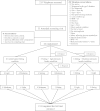Breaking up prolonged sitting reduces postprandial glucose and insulin responses
- PMID: 22374636
- PMCID: PMC3329818
- DOI: 10.2337/dc11-1931
Breaking up prolonged sitting reduces postprandial glucose and insulin responses
Abstract
Objective: Observational studies show breaking up prolonged sitting has beneficial associations with cardiometabolic risk markers, but intervention studies are required to investigate causality. We examined the acute effects on postprandial glucose and insulin levels of uninterrupted sitting compared with sitting interrupted by brief bouts of light- or moderate-intensity walking.
Research design and methods: Overweight/obese adults (n = 19), aged 45-65 years, were recruited for a randomized three-period, three-treatment acute crossover trial: 1) uninterrupted sitting; 2) seated with 2-min bouts of light-intensity walking every 20 min; and 3) seated with 2-min bouts of moderate-intensity walking every 20 min. A standardized test drink was provided after an initial 2-h period of uninterrupted sitting. The positive incremental area under curves (iAUC) for glucose and insulin (mean [95% CI]) for the 5 h after the test drink (75 g glucose, 50 g fat) were calculated for the respective treatments.
Results: The glucose iAUC (mmol/L) · h after both activity-break conditions was reduced (light: 5.2 [4.1-6.6]; moderate: 4.9 [3.8-6.1]; both P < 0.01) compared with uninterrupted sitting (6.9 [5.5-8.7]). Insulin iAUC (pmol/L) · h was also reduced with both activity-break conditions (light: 633.6 [552.4-727.1]; moderate: 637.6 [555.5-731.9], P < 0.0001) compared with uninterrupted sitting (828.6 [722.0-950.9]).
Conclusions: Interrupting sitting time with short bouts of light- or moderate-intensity walking lowers postprandial glucose and insulin levels in overweight/obese adults. This may improve glucose metabolism and potentially be an important public health and clinical intervention strategy for reducing cardiovascular risk.
Figures




References
-
- Dunstan DW, Barr EL, Healy GN, et al. Television viewing time and mortality: the Australian Diabetes, Obesity and Lifestyle Study (AusDiab). Circulation 2010;121:384–391 - PubMed
-
- Healy GN, Dunstan DW, Salmon J, et al. Breaks in sedentary time: beneficial associations with metabolic risk. Diabetes Care 2008;31:661–666 - PubMed
-
- Ceriello A, Esposito K, Piconi L, et al. Oscillating glucose is more deleterious to endothelial function and oxidative stress than mean glucose in normal and type 2 diabetic patients. Diabetes 2008;57:1349–1354 - PubMed

